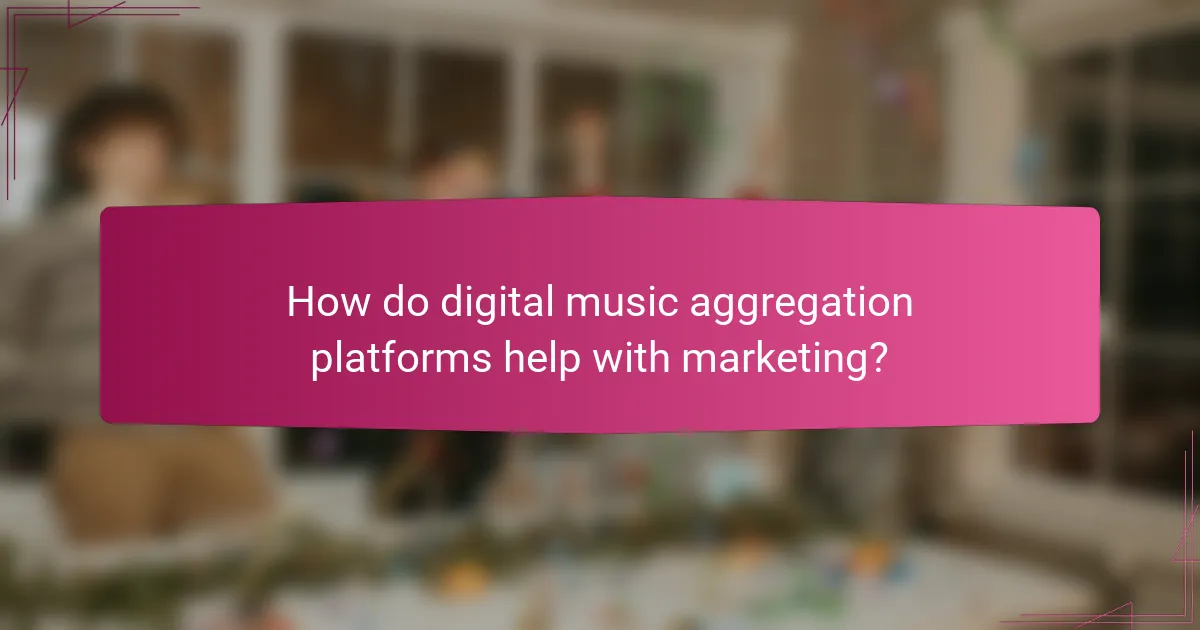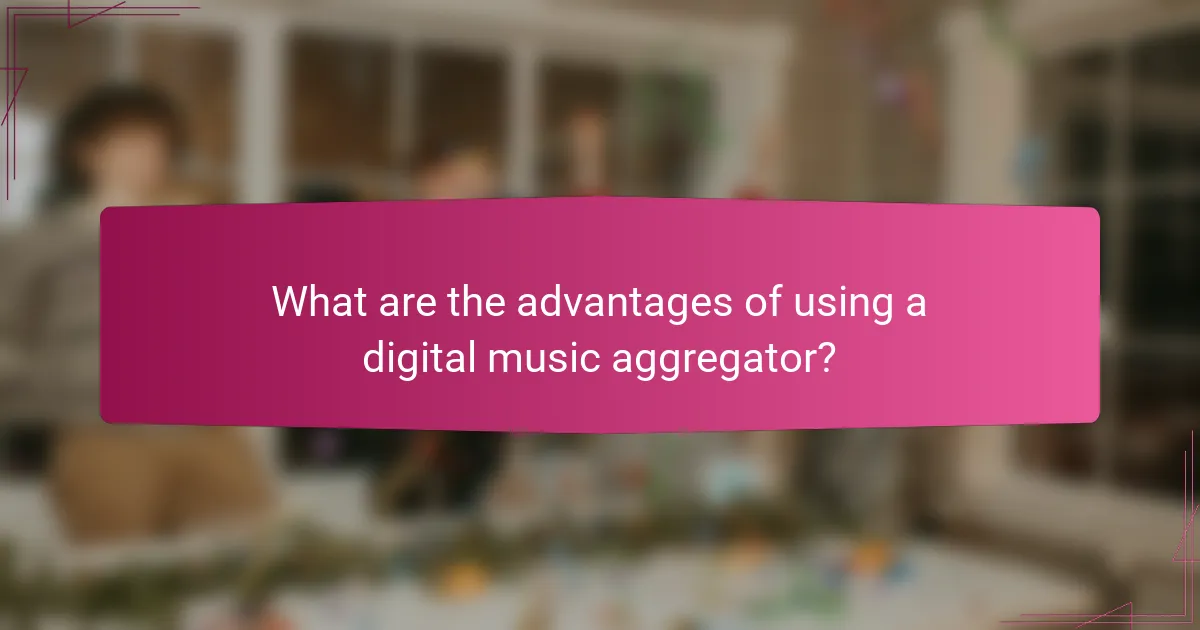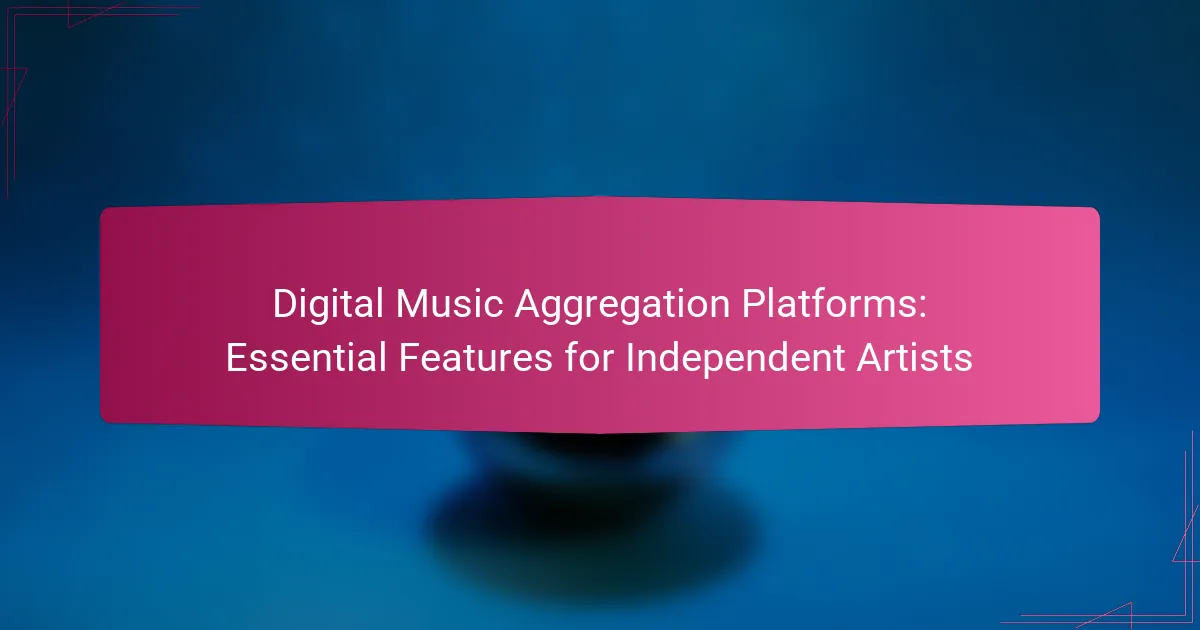Digital music aggregation platforms are vital for independent artists looking to distribute their music effectively. Services like CD Baby, TuneCore, and DistroKid provide essential features such as royalty collection, diverse distribution channels, and robust analytics. By choosing the right platform, artists can maximize their earnings and enhance their visibility in a competitive market.

What are the best digital music aggregation platforms for independent artists?
The best digital music aggregation platforms for independent artists include CD Baby, TuneCore, DistroKid, AWAL, and Symphonic Distribution. These platforms help artists distribute their music to various streaming services and online stores while offering different pricing models and features tailored to independent creators.
CD Baby
CD Baby is a popular choice for independent artists, providing a straightforward distribution process to major platforms like Spotify and Apple Music. Artists pay a one-time fee per album or single, and they retain 100% of their royalties, making it a cost-effective option for many.
In addition to distribution, CD Baby offers services such as music publishing, sync licensing, and promotional tools. This comprehensive approach allows artists to manage multiple aspects of their music career from one platform.
TuneCore
TuneCore operates on a subscription model, charging artists an annual fee to distribute their music. This model allows artists to keep 100% of their earnings, which can be appealing for those with a steady release schedule. TuneCore also provides detailed sales reports and analytics.
One consideration is that TuneCore’s fees can add up over time, especially for artists with multiple releases. However, the platform’s extensive reach and additional services, like publishing administration, can justify the cost for many musicians.
DistroKid
DistroKid is known for its low-cost, unlimited distribution model, allowing artists to upload as much music as they want for a single annual fee. This makes it ideal for prolific artists who release music frequently. DistroKid also offers features like automatic revenue splits for collaborations.
While DistroKid does not take a cut of royalties, artists should be aware that some services, like YouTube Content ID, may incur additional fees. Overall, DistroKid is a strong choice for artists looking for affordability and flexibility.
AWAL
AWAL is a distribution platform that focuses on independent artists with a strong potential for growth. Unlike other platforms, AWAL operates on an invite-only basis, selecting artists based on their music and engagement metrics. This exclusivity can lead to personalized support and marketing opportunities.
AWAL takes a percentage of the royalties, which can vary based on the artist’s agreement. This model can be beneficial for artists seeking more hands-on assistance and resources to help elevate their careers.
Symphonic Distribution
Symphonic Distribution offers tailored services for independent artists, including music distribution, marketing, and royalty collection. They provide a range of pricing options, including a flat fee or revenue share, depending on the artist’s needs and goals.
One of Symphonic’s strengths is its focus on building relationships with artists, offering personalized support and guidance. This can be particularly valuable for artists looking for a more collaborative approach to their music distribution strategy.

What essential features should independent artists look for in aggregation platforms?
Independent artists should prioritize platforms that offer comprehensive royalty collection, diverse distribution channels, robust analytics, and reliable customer support. These features ensure artists can effectively manage their music, maximize earnings, and gain insights into their audience.
Royalty collection
Royalty collection is crucial for independent artists as it directly impacts their earnings. Look for platforms that offer transparent and timely payments, ideally on a monthly basis. Some platforms may charge a percentage fee, so compare rates to ensure you retain a fair share of your income.
Consider platforms that provide detailed breakdowns of where your royalties are coming from, such as streaming services, digital downloads, and licensing. This transparency helps you understand which channels are most profitable and where to focus your marketing efforts.
Distribution channels
A wide range of distribution channels is essential for maximizing your music’s reach. Ensure the platform distributes to major streaming services like Spotify, Apple Music, and Amazon Music, as well as smaller platforms that cater to niche audiences. The more outlets your music is available on, the higher the chances of gaining listeners.
Some platforms also offer options for physical distribution, like vinyl or CD sales, which can be beneficial for artists looking to diversify their income. Check if the platform provides easy integration with social media for promotional purposes, as this can enhance your visibility.
Analytics and reporting
Analytics and reporting tools help artists track their performance and audience engagement. Look for platforms that offer real-time data on streams, downloads, and listener demographics. This information is vital for making informed decisions about marketing strategies and future releases.
Some platforms provide insights into geographic locations of listeners, which can guide your touring plans or targeted promotions. Regularly reviewing these analytics can help you adapt your approach and capitalize on trends in your music career.
Customer support
Reliable customer support can make a significant difference in your experience with an aggregation platform. Choose a platform that offers multiple support channels, such as email, chat, and phone, to ensure you can get help when needed. Responsive support can resolve issues quickly, preventing potential loss of income or exposure.
Consider reading reviews or seeking recommendations from other independent artists regarding the quality of customer support. A platform with a reputation for excellent service can save you time and frustration, allowing you to focus more on your music.

How do digital music aggregation platforms help with marketing?
Digital music aggregation platforms assist independent artists in marketing their music by providing tools and resources that enhance visibility and reach. These platforms streamline the distribution process while offering features that promote engagement with audiences across various channels.
Playlist placements
Playlist placements are crucial for gaining exposure in the music industry. Aggregators often have established relationships with curators and can help artists get their tracks featured on popular playlists, which can significantly increase streaming numbers and fan engagement.
To maximize the chances of playlist placements, artists should ensure their music is of high quality and fits the genre of the playlists they are targeting. Engaging with playlist curators and submitting tracks well in advance of release dates can also improve placement opportunities.
Social media integration
Social media integration is a key feature of digital music aggregation platforms, allowing artists to promote their music directly to their followers. Many platforms offer tools to share music links, create engaging posts, and even run targeted ads to reach new listeners.
Artists should leverage social media analytics to understand their audience better and tailor their promotional strategies accordingly. Regularly updating content and interacting with fans can help maintain interest and drive traffic to their music.
Promotional tools
Promotional tools provided by aggregation platforms can include email marketing, pre-save campaigns, and promotional pricing strategies. These tools help artists create buzz around new releases and maintain momentum in their marketing efforts.
Using these tools effectively requires planning and consistency. Artists should consider setting up a timeline for promotions and utilizing A/B testing to determine which strategies resonate best with their audience. Avoiding over-promotion is essential to keep fans engaged without overwhelming them.

What are the pricing models for digital music aggregation services?
Digital music aggregation services typically operate under various pricing models that can significantly impact an independent artist’s budget. Understanding these models—flat fee per release, annual subscription, and percentage of royalties—can help artists choose the best option for their needs.
Flat fee per release
The flat fee per release model charges artists a set amount for each single or album they distribute. This fee can range from around $10 to $50 per release, depending on the aggregator’s reputation and services offered.
This model is straightforward and allows artists to budget for their releases without worrying about ongoing costs. However, it may not be the most economical choice for artists planning to release multiple tracks in a short period.
Annual subscription
An annual subscription model requires artists to pay a yearly fee, which can range from approximately $50 to $200. This fee typically covers unlimited releases within that year, making it a cost-effective option for prolific artists.
While this model offers predictability in costs, artists should consider their release schedule to ensure they will benefit from the subscription. If an artist only plans to release one or two tracks a year, a flat fee per release might be more economical.
Percentage of royalties
The percentage of royalties model takes a cut of the revenue generated from music sales and streaming, usually ranging from 10% to 30%. This model can be appealing for artists who prefer to pay based on their success rather than upfront costs.
However, artists should be cautious, as high percentages can significantly reduce their earnings over time. It’s essential to read the fine print and understand what services are included in the fee to ensure it aligns with their financial goals.

What are the advantages of using a digital music aggregator?
Digital music aggregators provide independent artists with essential tools to distribute their music across various platforms, enhancing visibility and accessibility. They simplify the distribution process, allowing artists to focus more on their craft while reaching a broader audience.
Wider reach
Using a digital music aggregator allows independent artists to distribute their music to numerous streaming platforms and online stores, such as Spotify, Apple Music, and Amazon Music. This extensive reach increases the chances of gaining new listeners and expanding their fan base.
Aggregators often partner with various platforms, ensuring that artists’ music is available globally. This means that an artist’s work can be accessed by audiences in different countries, potentially leading to international recognition.
Time-saving
Digital music aggregators streamline the distribution process, saving artists valuable time. Instead of managing multiple accounts and submissions for each platform, artists can upload their music once and let the aggregator handle the rest.
This efficiency allows artists to focus on creating new music and engaging with their audience rather than getting bogged down in administrative tasks. Many aggregators also provide tools for tracking sales and streams, further simplifying the management of their music career.
Professional support
Many digital music aggregators offer professional support services, including marketing advice, royalty management, and analytics. This support can be crucial for independent artists who may not have the resources to hire a full team.
Additionally, some aggregators provide educational resources, helping artists understand the music industry better and make informed decisions. This guidance can empower artists to navigate challenges and optimize their strategies for success.

What are the common challenges faced by independent artists in digital distribution?
Independent artists often encounter several challenges in digital distribution, including limited resources, lack of industry connections, and difficulties in navigating various platforms. These hurdles can hinder their ability to effectively reach audiences and monetize their music.
Limited Financial Resources
Many independent artists operate on tight budgets, which can restrict their marketing efforts and distribution options. Without substantial funding, they may struggle to invest in professional-quality recordings, promotional campaigns, or even the fees associated with digital distribution platforms.
To maximize impact on a budget, artists should focus on cost-effective marketing strategies, such as leveraging social media and engaging with fans directly. Utilizing free or low-cost digital distribution services can also help minimize upfront costs while still getting their music to listeners.
Navigating Multiple Platforms
Independent artists often face the challenge of managing their music across various digital distribution platforms, each with its own requirements and processes. This can lead to confusion and inconsistency in how their music is presented to audiences.
To simplify this process, artists should consider using an aggregator that distributes music to multiple platforms simultaneously. This approach saves time and ensures that their music appears consistently across services like Spotify, Apple Music, and Amazon Music.
Building an Audience
Establishing a loyal fan base is crucial for independent artists, yet it can be difficult without the backing of a record label. Artists must actively engage with potential listeners and promote their music through various channels.
Effective strategies include hosting live performances, utilizing social media for direct engagement, and collaborating with other artists to reach new audiences. Regularly releasing new content can also keep fans interested and attract new listeners.
Understanding Royalties and Revenue Streams
Independent artists often struggle to understand the complexities of royalties and revenue from digital music sales. Different platforms have varying payout structures, which can make it challenging to predict earnings accurately.
Artists should educate themselves about how royalties work and consider using tools that provide transparency in revenue tracking. Keeping detailed records of sales and streams can help them assess which platforms are most profitable and adjust their strategies accordingly.
